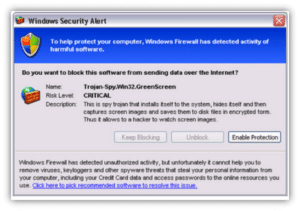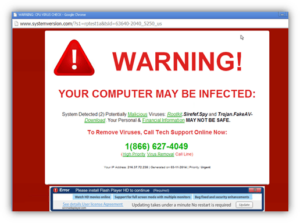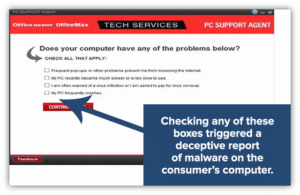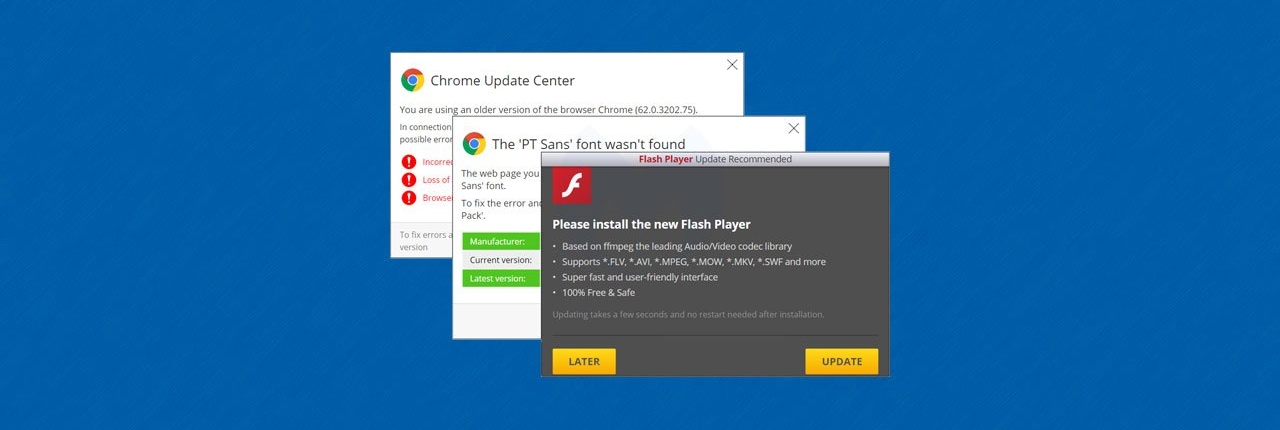Explore what scareware is & how it infects devices. We’ll also share scareware examples & how to protect yourself from scareware scams
Imagine that you’re surfing the internet when, suddenly, you receive a notification telling you that your computer is infected with multiple viruses! The message appears legitimate and says that using their antivirus software will eliminate the threats. But, in reality, all it does is allow worthless or malicious software to install on your device. This is just one of many scareware example scenarios users have encountered over the years.
But exactly what is scareware? And why is it something that all users should be aware of when using the internet?
What Is Scareware?
Scareware refers to scam tactics and fake software applications that cybercriminals use to incite feelings of panic and fear. They do this to get users to make irrational split-second decisions and to trick them into:
- Buying worthless software,
- Downloading different types of malicious software, or
- Visiting websites that auto-download and install malicious software onto their devices.
Scareware scammers use social engineering tactics and language that create a sense of urgency in their targets to compel their targets to act. But how do they reach their victims? They frequently rely on pop-ups that are designed to look like antivirus alerts. In some cases, the messages can take over part (or all) of the target’s screen.
What Does Scareware Do?
At best, the software does nothing and “only” costs you the money you spent to buy it. But oftentimes, the software causes harm by installing malicious software that can:
- Commandeer your computer
- Spy on you
- Result in data theft
- Lead to further financial losses
Some types of scareware rely on the user downloading the software. Others will auto-download without the user’s knowledge or consent. But why bother doing this at all? The purpose of the scareware can be to achieve any of the following:
- To make people buy the rogue software, which is non-functional.
- To make people install the software, which contains malware in itself.
- To steal victims’ payment card numbers, bank account details (which they use to purchase the software), or personally identifiable information (PII), to deploy further financial fraud or identity theft-related crimes.
To better answer the question “what is scareware?” let’s look at a few scareware examples.



How Does Scareware Work?
Not sure how a scareware scam works? Basically, it involves using social engineering-based tactics to manipulate people into downloading or buying software. Now, the software could be harmless; but in some cases, it could be downright nasty and malicious. In either case, the goal is to get victims to pay the scammer or get them to install software by eliciting fear and a sense of urgency.
Here are some common methods that scareware operators (hackers) use to carry out their scareware attacks and to distribute malware:
- Pop-Ups: We’ve already talked about this, but pop-up messages and alerts are a common way for cybercriminals to deploy scareware.
- Malvertising: Malvertising = malicious advertising. In the case of scareware, hackers use third-party ad distributors to display phony or malicious ads on websites (with or without their knowledge). Cybercriminals spread various types of malware, including scareware displaying fake antivirus advertisements on reputed websites and apps via malvertising.
- Downloads/Installations: The hackers lure the victims by offering free goodies — such as software, songs, images, videos, PDF files of popular books, etc. — and hide scareware malware inside them. They might also make replicas of popular apps and software to trick users into downloading them instead of the legitimate ones.
- Phishing Emails: The attacker sends you a phishing email with a warning that your device is infected and offers you rogue antivirus software or tech support. They might also send you emails impersonating a company or person you trust and send the scareware malware as an attachment. The attachment looks like a benign purchase receipt, transaction document, business file, or free media file. But when you click on it, scareware downloads onto your device.
- Infected Websites: The attackers make websites that capture users’ attention, and when users visit such sites, the scareware pop-ups take over the screen.
What Happens to the Scareware Victims?
Let’s find out what happens if you fall for such a scareware attack.
- You get useless software. Okay, while it’s not ideal, this isn’t as bad as some other scenarios that we’ll talk about momentarily. With this type of scareware, you end up paying for fake and worthless software that doesn’t perform any of the promised malware detection and removal services.
- You pay money for fake tech support. You might make the call on the given number, they provide the fake virus removal service (fake because your PC is not infected in the first place), and you pay for it.
- Cybercriminals steal your payment card info. When you make a payment for buying the fake antimalware software or tech support, the hacker steals your payment card number or bank details. They misuse this data to deploy financial fraud in the future.
- Cybercriminals steal your personally identifiable information (PII). Before buying the fake software or service, you might be asked to fill a form with your PII such as name, phone number, physical address, email address, date of birth, type of device you are using, etc. Sometimes hackers collect this information and sell it to marketers or other hackers on the darknet.
- You install malware onto your device. Like the last example, this scenario also spells disaster for you. The fake antivirus program itself can be a malicious trojan horse. Once you install it on your device, cybercriminals can:
- Use your device as a botnet to execute other cybercrimes
- Install spyware that takes a screenshot of your activities and blackmail you into leaking your sensitive data if you don’t pay the extortion money
- Steal your credentials and other sensitive information
- Install ransomware on your device that encrypts the files or locks the device and allows them to demand ransom to get back the access
- Spread malware to all of your other files, software, applications, and the operating system
- Spread virus via your Wi-Fi and infect other connected IoT devices on your network
- Take control of your email client and send a phishing email to your contacts
- Access your social media profiles and send malware-loaded attachments to your friends or ask them to transfer money from your profiles.
How to Protect Yourself Against Scareware
Follow these steps if you encounter scareware.
1. Install Robust Security Software on Your Device
Security software (i.e., antivirus, antimalware, antispyware, firewall, etc.) is your first line of defense against scareware. It scans your device in real-time, detects, and removes many types of malware, including scareware. When you accidentally or intentionally try to visit a scareware-laden site, the good security software blocks these websites and downloads or shows you an alert notification.
2. Use Common Sense
Just because you see a pop-up window, email, or an ad banner telling you that your device is infected with viruses, you shouldn’t automatically believe it. Never download or install any unknown security software or call tech-support numbers believing such pop-ups even if you see signs of malware infection. Instead, download and scan your device with only with some reputed and trusted antivirus programs like Bitdefender
3. Close the Window and Quarantine Your Device
Don’t use the “X,” “cancel,” or “close” buttons to close the window. It might trigger automatic malware downloads. Instead, close your browser by pressing Ctrl-Alt-Delete. If you see a scareware window and can’t get rid of it, disconnect your device from Wi-Fi and all other connected IoT devices (like your printer, scanner, router, etc.). Then, open the device in safe mode and scan it with a trusted antivirus program. If that doesn’t work, you can turn your computer to a reliable tech-support center or professional in your area.
4. Wipe Your Device’s Memory
This should be your last option and is something you can employ if you have scareware on your device. Use it if the scareware infection is spread in a way that you can’t open any files, browser, or access anything, and the security program and tech support professional can’t solve the issue. By wiping out the device’s memory, you will lose all the saved data of your device and won’t be able to recover anything after that. But on the other side, you will be able to get rid of all the scareware traces and save your device.
Final Words on Scareware
Not everyone is tech-savvy and aware of various cyber threats. But after reading this article, you know what scareware is and that if you see a potential scareware notification, you shouldn’t panic or make a fear-based decision. The best defense against the scareware is to:
- Be vigilant,
- Not click on or otherwise engage with unsolicited messages or pop-ups, and to
- Use a strong antivirus/anti-malware solution.

